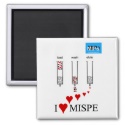|
|
Reference type: Journal
Authors: Yoshikawa M, Kondo Y, Morita Y
Article Title: Relationship between enantioselectivity of alternative molecularly imprinted polymeric membranes and species of amino acid residues composing chiral recognition sites.
Publication date: 2002
Journal: Bioseparation
Volume: 10
Issue: (6)
Page numbers: 323-330.
DOI: 10.1023/A:1021593804480
Abstract: Molecularly imprinted polymeric membranes with tetrapeptide residue H-Asp(OcHex)-Asp(OcHex)-Asp(OcHex)- Asp(OcHex)-CH2- (DDDD) or H-Glu(OBzl)-Glu(OBzl)-Glu(OBzl)-Glu(OBzl)-CH2- (EEEE) were prepared during membrane preparation (casting) processing in the presence of print molecules. The Boc-L-Trp imprinted polymeric membranes thus obtained showed adsorption selectivity toward Ac-L-Trp from its racemic mixtures. From adsorption isotherms of Ac-Trp, the chiral recognition site, that had been formed by the presence of print molecules in the membrane preparation process, exclusively recognized Ac-L-Trp that possessed the same configuration of the print molecule. The affinity constants between chiral recognition sites in the membrane and Ac-L-Trp was determined to be 1.00 x 10(4) mol(-1) dm(3) and 1.08 x 10(4) mol(-1) dm(3) for the DDDD and EEEE membranes, respectively. Enantioselective electrodialysis could be attained by applying an optimum potential difference to give permselectivity, with a value close to its adsorption selectivity
|


 MI cryptic logo mug
MI cryptic logo mug







 multi MIPs logo mousemat
multi MIPs logo mousemat







 I love MISPE magnet
I love MISPE magnet






